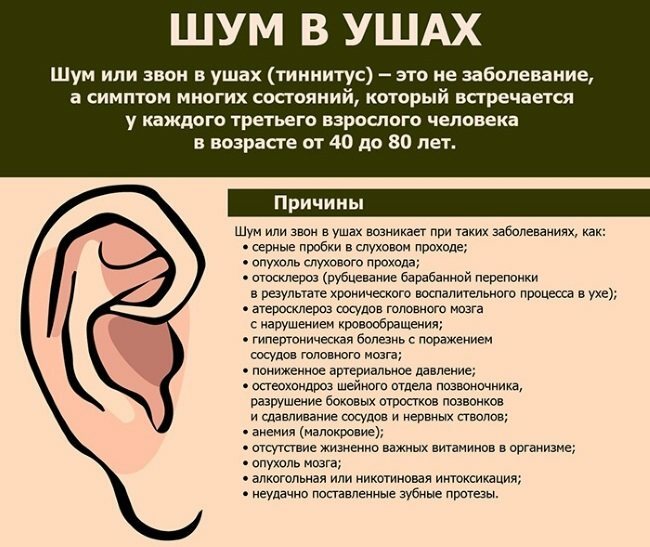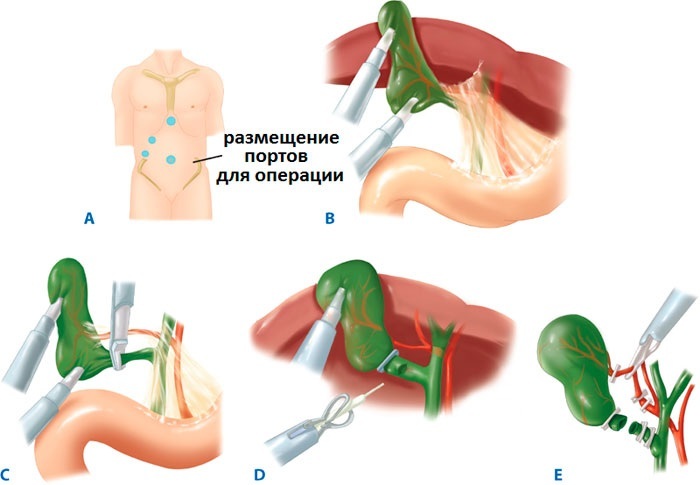Content
- Functions and work of taste receptors
- Types of tongue receptors
- Layout of the taste buds of the tongue
- What types of papillae have receptors?
- How many tastes a person recognizes
- Why should a person recognize tastes?
- What does it mean if you want food of a certain taste
- Video on how the sense of taste arises
There are approximately 10,000 taste receptors in the oral cavity. They are located on the inner surface of the cheeks, adjacent tissues of the palatine part and the epithelial covering of the tongue. Also, sensory cells, due to which the transmission of sensations to the brain occurs, can be located on the larynx and pharynx. They are capable of performing various functions. According to the degree of aging, their number decreases.
Functions and work of taste receptors
There are 3 analytical cell types, which differ from each other in shape and size. They contain mechanical and thermal receptors, which make it possible to distinguish hot from cold, set moisture and texture, and also respond to other features of food.
All cells are characterized by the same functional recognition mechanism. The main analytical tool is chemoreceptors, which are necessary for establishing taste. With respect to the cell type, the sensory components are characterized by a different protein complex.

In the process of interaction with a certain chemical irritant, such compounds are able to change own properties, changing the received signals into nerve impulses that are sent to the cerebral cortex brain.
Chemoreceptors perceive not only 4 main gustatory sensations, but also intermediate ones:
- mint;
- spicy;
- spicy;
- tart.
The largest receptors of the tongue are considered to be grooved, called cylindrical. They are mainly located in the area of the root of the organ. They contain the glands, cushion and body. The grooved chemoreceptors contain protein compounds that are able to determine the bitter taste.
A sense of taste arises due to certain types of linguistic chemoreceptors, which have the following purposes:
| Receptor type | Functions |
| Mushroom | In addition to the central line, they are located over the entire surface of the tongue. Their main task is to recognize the sweet taste. A huge volume of such cells is located in the lower end of the organ. |
| Conical | In the range of one cell colony, they combine and coexist with filamentous components. They are characterized by the same anatomical structure and functional purpose. However, they have a different chemical composition. Cone receptor cells are able to perceive the mechanical characteristics of food. At the same time, they have thermal and pain sensors. |
| Leafy | Located in the area of the palatine arches. They are characterized by an oval geometric configuration. The chemical structure contains proteins that are able to react to a bitter taste. |
| Filiform | Small bulky cells that perceive food tactilely and hold it in the mouth. They lack a protein compound that can react to various chemical irritants in the mouth. |
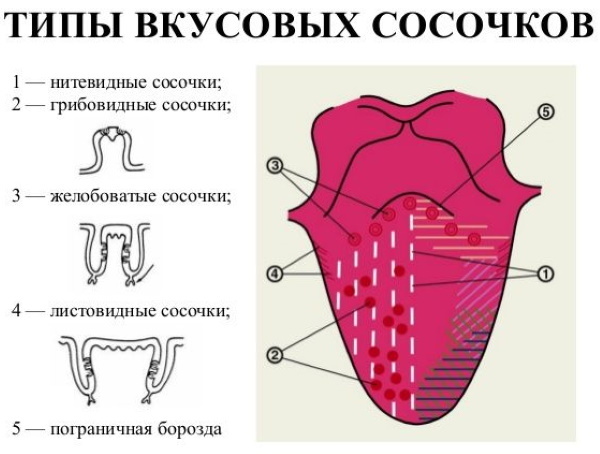
Taste receptors of the tongue are characterized by a combining and alternating arrangement. Their functional purpose is closely intertwined with the activity of the olfactory and tactile sensory cells. To transmit analytical information about the properties of food, 2 channels are used - glossopharyngeal and nasal, which are completely covered with nerve fibers.
Types of tongue receptors
Language receptors are characterized by different specifications. They have both thermoreceptors, which recognize the temperature regime of food, and mechanoreceptors, which help to determine the consistency of foods. However, the main evaluative tool that is present in the language are chemoreceptors, which are responsible for determining taste. Such a mechanism is able to distinguish edible from inedible, which establishes success in survival.
A sense of taste arises from the kidneys, which are located on the surface of the tongue, as well as in the pharynx and on the hard palate.
In chemoreceptors there is a special protein complex, which upon contact with various chemical stimuli is able to change personal properties by converting the acquired signal into a nerve impulse. The latter goes directly to the brain.
For a long period of time, scientists believed that there are exclusively 4 specific taste types, distinguishable by language receptors:
- bitter;
- sour;
- sweet;
- salty.

However, the 5th type of taste also stands out, called umami. Some receptors in the papillae of taste react to it. This type is able to characterize components with a huge amount of protein, namely: some vegetables, mushrooms, nuts, cheeses, as well as meat and seafood in ready-made form.
An alternative classification refers to the above flavors as alkaline, pungent, minty and tart. The facial nerve canal controls the anterior 2/3 of the tongue, and the glossopharyngeal canal controls the last third of the tongue. Thanks to them, the taste signal is sent to the brain.
Layout of the taste buds of the tongue
Taste receptor cells are located throughout the organ. They unite in colonies, which are characterized by different sizes and shapes. They are also called papillae. In the range of one linguistic region, taste-sensitive components are concentrated, which differ from each other in functions and configuration. On the surface of the tongue, they are unevenly layered. They are grouped in a special way.
Colonies of very small chemoreceptors, which send nerve impulses of taste sensations to the cerebral cortex, are combined into bundle formations-protrusions. At the same time, they are attached to special movable papillae, which are characterized by a bulbous shape.
Such physiological components that cover the surface of the tongue are protected by small tubercle-like lumps. The papillary processes-bulbs have different sizes. In large formations there are about 500 taste buds, in small - less than 10.
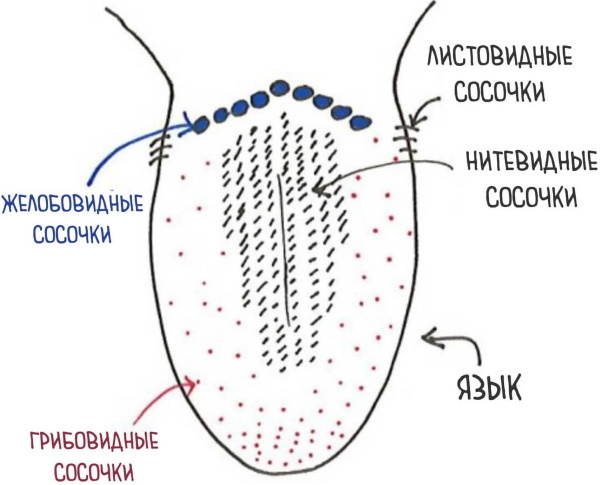
The acquired information about the peculiarities of food dissolved in saliva enters the cerebral cortex with the help of a system of nerve fibers of a complex anatomical structure. On the back, they are attached to the analytical cells.
The placement and approximate concentration of the taste buds of the tongue are the same for everyone. They are located mainly in the upper region of the organ and are responsible for determining bitterness. Sensory cells, which create colonies along the linguistic contour, at the very edge of the organ, send information to the brain about the salty and acidic environment.
The layout of the receptors that are capable of responding to a sweet taste shows them accumulating in an arched formation in the region of the lower part of the tongue.
Each of the groups is also characterized by different sensory cells. The rest of the receptors, which are in the range of one colony, allow us to perceive the subtle nuances of the food consumed and intermediate tastes. By combining sensory cells with transmitting nerve fibers, neuroepithelial structures are created.
What types of papillae have receptors?
Taste buds are divided into grooved, fungiform and filiform formations. Each type contains a huge volume of receptor cells of the same type. In cylindrical papillae, leaf-like biological sensors are mainly located, which are responsible for the occurrence of various sensations. In filiform associations, filamentous and conical receptors are closely interconnected.
Fungiform papillae are formed thanks to mushroom-shaped organic taste analyzers. In the human language, there are basically a lot of papillae of the last two types. The epiglottis contains the smallest volume of taste papillae. They stretch to the beginning of the esophagus. In the area of the palatine tonsils, the grooved papillae are located. Also, in small quantities, they can be located in the soft tissues that support the tongue.
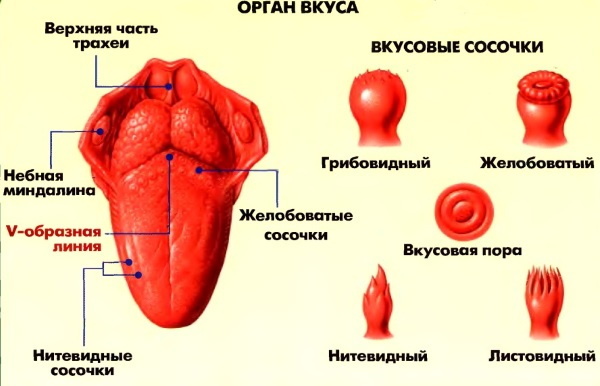
The leaf-shaped and mushroom papillae contain the largest volume of chemical receptors. When gustatory stimuli enter the oral cavity, ion channels and sensory cells of the papillae come into play.
Ultimately, a chemical reaction releases neurotransmitters that enter the cerebral cortex. However, this physiological mechanism is not fully understood. Bitter and sweet tastes can be perceived by papillary sensory cells, which contain proteins of the T2R, T1R and G classes.
How many tastes a person recognizes
Basically, a person can recognize 4 standard tastes: salty, bitter, sweet and sour. However, about 30 years ago, a fifth taste was developed in Japan, which is called "umami".
Features of the perception of various tastes:
- Bitter. There is an opinion that bitter foods can cleanse the intestines with the stomach, as well as the blood with the brain. Bitter can soothe irritation on the skin, as it is characterized by anti-inflammatory effects. However, excessive consumption can provoke dizziness, severe headaches and seizures.
- Sour. Components containing ascorbic acid have a characteristic sour taste. They have a beneficial effect on the process of digestion of food in the stomach, normalizing blood pressure and thinning the blood. Fermented foods, sour cream, vinegar, sorrel, lime, lemon and wild berries have a pronounced sour taste. However, with an increased intake of acidic ingredients, there is a deterioration in vision, a decrease in potency, the appearance of wrinkles and thinness. There are also problems with teeth and joints.
- Sweet. It is considered the favorite flavor of many people. It is found in foods that contain a huge amount of glucose used as fuel for the body. Sweet has a positive effect on the healing of fractures, can strengthen the body, improve the condition of the eyes and hair, and increase the volume of blood and muscle tissue. The sweet ingredients help the body produce the hormone endorphin and serotonin. However, if there is a huge amount of sugary food in the diet, the amount of fat and the number of putrefactive bacteria in the intestines increases. As a result, hemorrhoids, cracks in the tissues and a huge accumulation of gases appear.
- Salty. It is table salt that is considered the main component that corresponds to salty food. She is able to give products a pronounced flavor, increasing the feeling of hunger and thirst. If you eat a lot of salty foods, skin rashes, swelling, scabies and rashes appear.
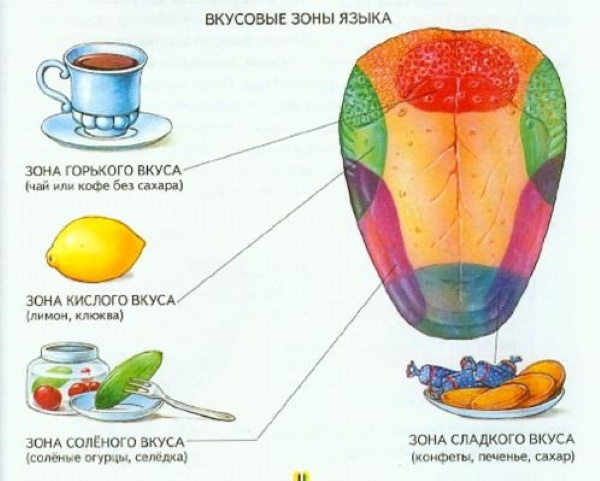
In the course of research with the national Japanese cuisine, scientists have developed substances that can give the product a piquant taste. The “umami” taste is mainly from monosodium glutamate. It is felt in the process of consuming dried mackerel, soy sauce, or tomatoes. In its pure form, it is not very pleasant. However, its insignificant concentration can impart an unusual taste to the treat.
Other tastes that a person is able to experience are a combination of 4 basic ones. They are selected in certain proportions. For example, an apple can be both sour and sweet. Components that have a pure taste will be perceived by a person in the same way.
Why should a person recognize tastes?
The ability of the human senses to recognize tastes is considered the most ancient. Over a long period of time, this ability has evolved along with a person, since the choice poor-quality food can provoke a loss of energy, as well as cause health problems, which can cause of death. During the period of his own development, a person consciously established that if he needs energy, then it is necessary to find sweet food.
If the body lacks salts and minerals, therefore, it needs salty foods. If there is a need to replenish the supply of amino acids and proteins, the body needs umami-flavored food. The receptors that are able to respond to sour and bitter were inherited by ancestors. The sour taste suggested that the person was not fully ripe or spoiled fruit. The bitter taste was considered a warning that there was poison in food.

Therefore, the ability to distinguish between bitter and sour made it possible to protect primitive man from poisoning. However, today sour taste marks not only sour food or unripe fruit, but also a source of vitamin C. Ascorbic acid is very necessary for survival, but the body is not able to produce it, and therefore the body looks for it in food.
A sense of taste arises due to the effect of chemical elements on the receptors that are located on the organ. If the tongue comes in contact with alcohols or carbohydrates, a sweet taste arises in the mouth. Sodium and potassium salts can produce a salty taste. Bitterness is due to the influence of alkaloids, which are often considered poisonous. If there is a relationship of hydrogen ions with taste buds, a sour taste is formed.
The ability of the body to distinguish tastes and respond to receptor signals will depend not only on the ability to identify dangerous food, but also 2 vital functions:
- The first is able to activate the production of gastric juice. Therefore, the speed of food digestion will also depend on the ability to recognize tastes.
- It depends on the second that the language receptors bring pleasure from the food consumed. The secretion of happiness hormones will increase in the body and the mood will rise if a person eats his favorite food.
What does it mean if you want food of a certain taste
The body sometimes wants a certain taste: sweet, salty or sour. There is no need to repulse such signals. If you crave something sweet, your body may not have enough energy, as these foods contain glucose, which is used as fuel. If endorphin and serotonin levels, which control well-being, are sharply reduced, sugar may be needed.
As a result, most people use chocolate on an unconscious level to cope with stress. Taste receptors send a signal to the brain. The latter begins to produce the components it needs to improve mood. However, one should not constantly satisfy the needs of the body. With the frequent use of sweets to cope with stress and bad moods, obesity can occur.
With a deficiency of vitamin C, the body needs acidic. Ascorbic acid is able to strengthen the immune system and cope with colds. However, you should not use such a substance in excessive quantities. Sour food can have a detrimental effect on tooth enamel. You don't need to constantly consume kiwi or citrus fruits to give your body vitamin C.
You can eat bell peppers, which are considered not sour food, but there is a lot of ascorbic acid in it. If you crave salty, therefore, the body lacks minerals. However, you do not need to consume salt. To restore stocks of useful elements, it is enough to eat nuts, cereals, salad based on vegetables and fruits. Excessive consumption of salt can provoke the development of various diseases.

However, if the weather is hot outside, the body needs to be given salt. During the summer, this signal indicates that dehydration has occurred. The food product is able to retain moisture in the tissues, preventing heat stroke and dehydration.
The body generally does not require bitter food. However, if you do not want salty, sour or sweet, you may need to eat dark chocolate. This happens if there is a breakdown or a decrease in mental performance. A bar of chocolate can boost brain activity.
If you often want to use certain components, it is recommended to consult a doctor, because this may be the cause of the development of the disease. In the human body, there is a huge amount of taste receptors, thanks to which sensations are formed that allow you to stop swallowing dangerous elements and evaluate the quality of food eaten. Therefore, the receptor system of the tongue must constantly work correctly.
Video on how the sense of taste arises
The mechanism of the onset of taste sensations:


